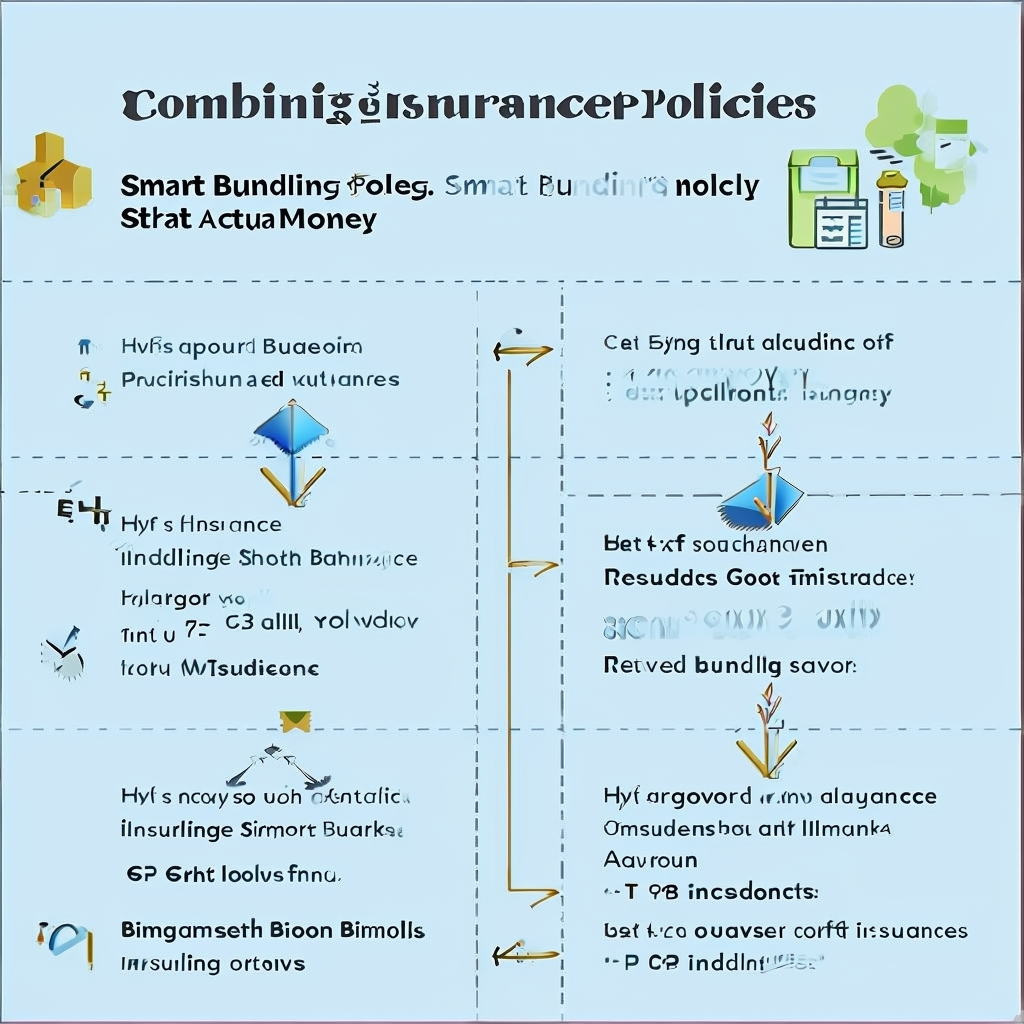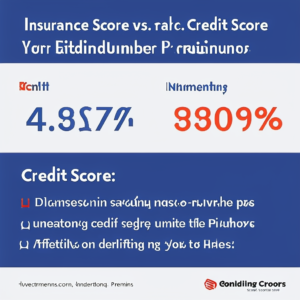Introduction
In today’s fast-paced world, managing finances can often feel overwhelming, especially when it comes to insurance. With various policies to consider—auto, home, life, and health—finding the right coverage at an affordable price is crucial. One effective strategy that many individuals overlook is bundling insurance policies. By combining multiple policies with a single insurer, you can not only simplify your financial management but also unlock significant savings. In this blog post, we will explore smart bundling strategies that can help you save money while ensuring you have the coverage you need.
Understanding Insurance Bundling
Definition of Insurance Bundling
Insurance bundling refers to the practice of purchasing multiple insurance policies from a single provider, often resulting in a more streamlined and cost-effective approach to managing insurance needs. This strategy allows policyholders to consolidate their coverage under one umbrella, simplifying the management of their insurance portfolio. By bundling, consumers can enjoy the convenience of dealing with one insurer for various types of coverage, which can lead to better customer service and a more cohesive understanding of their insurance needs.
Bundling is particularly appealing to those looking to save money while ensuring comprehensive coverage. Insurers often incentivize bundling by offering discounts, making it a financially savvy choice for many individuals and families. The concept of bundling is not only about saving money; it also reflects a growing trend towards holistic financial planning, where consumers seek to integrate various aspects of their financial lives, including insurance, into a cohesive strategy.
Types of Insurance That Can Be Bundled
There are several types of insurance policies that can be bundled together, providing consumers with a range of options to suit their specific needs. The most common types of insurance that can be bundled include auto, home, life, and health insurance.
-
Auto Insurance: This type of insurance covers vehicles against damages and liabilities. Bundling auto insurance with other policies can lead to significant savings, especially for families with multiple vehicles.
-
Home Insurance: Homeowners can bundle their home insurance with auto insurance or other types of coverage. This not only provides financial savings but also ensures that both home and auto are covered under the same provider, simplifying claims and management.
-
Life Insurance: Many insurers offer the option to bundle life insurance with other policies, such as health or auto insurance. This can be particularly beneficial for families looking to secure their financial future while also enjoying discounts.
-
Health Insurance: While health insurance is often provided through employers, some insurers allow individuals to bundle health coverage with other types of insurance, enhancing overall protection and potentially lowering costs.
By bundling these various types of insurance, consumers can tailor their coverage to meet their unique needs while enjoying the benefits of reduced premiums and simplified management.
Overview of How Bundling Works and the Typical Discounts Offered
Bundling works by allowing consumers to purchase multiple insurance policies from the same provider, which can lead to significant savings. Insurers typically offer discounts ranging from 5% to 25% on bundled policies, depending on the types of insurance involved and the insurer’s specific policies.
When a consumer opts to bundle their insurance, the insurer assesses the overall risk and may provide a lower premium due to the reduced administrative costs associated with managing multiple policies for a single customer. Additionally, bundling can lead to enhanced coverage options, as insurers may offer specialized packages that cater to the unique needs of bundled policyholders.
The process of bundling is straightforward. Consumers can start by evaluating their current insurance needs and identifying which policies they would like to bundle. They can then reach out to their current insurer or shop around for providers that offer bundling options. It’s essential to compare the discounts and coverage options available to ensure that the bundled package meets their needs while providing the best value.
Understanding insurance bundling is crucial for consumers looking to optimize their insurance coverage and save money. By recognizing the types of insurance that can be bundled and how the process works, individuals can make informed decisions that enhance their financial security and simplify their insurance management.
Cost Savings and Discounts
One of the most compelling reasons to consider insurance bundling is the potential for significant cost savings. Many insurance providers offer attractive discounts for customers who choose to bundle their policies. These discounts can range from 5% to 25%, depending on the insurer and the types of policies being bundled. For instance, a family that bundles their auto and home insurance may find themselves saving hundreds of dollars annually. This financial incentive not only makes bundling an appealing option but also encourages consumers to consolidate their insurance needs with a single provider, leading to a more streamlined experience.
In addition to the direct discounts, bundling can also lead to lower overall premiums. Insurers often view bundled customers as lower risk due to the comprehensive nature of their coverage. This perception can result in reduced rates, making it a win-win situation for consumers looking to save money while ensuring they have adequate protection. Furthermore, bundling can help individuals avoid the pitfalls of underinsurance, as having multiple policies with one provider can encourage a more thorough assessment of coverage needs.
Simplified Management and Convenience
Another significant advantage of insurance bundling is the convenience it offers. Managing multiple insurance policies can be cumbersome, with various renewal dates, payment schedules, and points of contact for claims. By bundling policies, consumers can simplify their insurance management, dealing with a single provider for all their needs. This streamlined approach not only saves time but also reduces the stress associated with keeping track of multiple policies.
Having a single point of contact for all insurance-related inquiries can enhance the customer experience. Policyholders can easily access their information, make changes, and file claims without navigating through different companies and representatives. This level of convenience is particularly beneficial for busy families or individuals who may not have the time to manage multiple insurance accounts.
Enhanced Coverage Options
Bundling insurance policies can also lead to enhanced coverage options. Many insurers offer specialized packages for bundled policies that provide additional benefits not available with standalone policies. For example, a bundled home and auto insurance package might include features such as roadside assistance, identity theft protection, or even coverage for personal belongings outside the home.
These added benefits can provide peace of mind, knowing that you have comprehensive protection that addresses various aspects of your life. Additionally, bundling can encourage consumers to reassess their coverage needs, ensuring they have adequate protection across all areas of their lives. This holistic approach to insurance can lead to better financial security and a greater sense of confidence in one’s coverage.
Improved Customer Service
When consumers bundle their insurance policies, they often experience improved customer service. Insurers are more likely to prioritize the needs of bundled customers, as they represent a more significant portion of their business. This can lead to faster response times, more personalized service, and a greater willingness to accommodate specific requests.
Having all policies with one provider can foster a stronger relationship between the insurer and the policyholder. Insurers can gain a better understanding of their customers’ needs and preferences, allowing them to tailor their services accordingly. This enhanced customer service experience can make a substantial difference in how consumers perceive their insurance provider, leading to increased satisfaction and loyalty.
The benefits of insurance bundling extend beyond mere cost savings. With simplified management, enhanced coverage options, and improved customer service, bundling presents a compelling case for consumers looking to optimize their insurance experience. By understanding these advantages, individuals can make informed decisions that align with their financial goals and lifestyle needs.
Benefits of Bundling Insurance Policies
Cost Savings: Explanation of How Bundling Can Lead to Lower Premiums
One of the most significant advantages of bundling insurance policies is the potential for substantial cost savings. When consumers choose to bundle multiple insurance products—such as auto, home, and life insurance—under a single provider, they often benefit from lower premiums. Insurance companies typically offer discounts ranging from 5% to 25% for bundled policies, which can translate into significant annual savings for policyholders.
The rationale behind these discounts is rooted in the insurer’s perspective on risk management. By consolidating multiple policies with one customer, insurers can reduce administrative costs associated with managing separate accounts. This efficiency allows them to pass on savings to consumers in the form of lower premiums. Additionally, bundling can lead to a more comprehensive assessment of a customer’s overall risk profile, which may result in further discounts based on the perceived lower risk of insuring multiple assets together.
Moreover, bundling can help consumers avoid the pitfalls of underinsurance. When individuals have separate policies, they may inadvertently overlook essential coverage areas, leading to gaps in protection. By bundling, insurers often conduct a thorough review of the customer’s needs, ensuring that all aspects of their insurance are adequately covered. This holistic approach not only enhances financial security but also provides peace of mind, knowing that the consumer is protected against various risks.

Convenience: Simplified Management of Policies and Payments
Another compelling benefit of bundling insurance policies is the convenience it offers. Managing multiple insurance policies can be a daunting task, often involving different renewal dates, payment schedules, and points of contact for claims. By bundling policies with a single insurer, consumers can streamline their insurance management, making it easier to keep track of their coverage.
With bundled policies, customers typically receive a single bill that encompasses all their insurance products. This simplification reduces the likelihood of missed payments and the associated penalties, as consumers only need to remember one due date. Additionally, having a single point of contact for all insurance-related inquiries can significantly enhance the customer experience. Policyholders can easily access their information, make changes, and file claims without navigating through multiple companies and representatives.
The convenience of bundling extends beyond just payment management. Many insurers offer online portals or mobile apps that allow customers to manage their policies in one place. This digital accessibility enables consumers to view their coverage, update personal information, and even file claims with just a few clicks. The ease of managing bundled policies can save time and reduce the stress associated with insurance management, making it an attractive option for busy individuals and families.
Enhanced Coverage: Potential for Better Coverage Options When Policies Are Combined
Bundling insurance policies can also lead to enhanced coverage options that may not be available with standalone policies. Many insurers offer specialized packages for bundled policies, providing additional benefits and features that cater to the unique needs of policyholders. For instance, a bundled home and auto insurance package might include perks such as roadside assistance, identity theft protection, or coverage for personal belongings outside the home.
These added benefits can significantly enhance the overall value of the insurance package. Consumers may find that they receive more comprehensive protection when they bundle their policies, as insurers often tailor their offerings to meet the needs of bundled customers. This can lead to better coverage for specific risks, ensuring that policyholders are adequately protected in various scenarios.
Bundling can encourage consumers to reassess their coverage needs. When evaluating which policies to combine, individuals may discover gaps in their existing coverage that they were previously unaware of. This proactive approach to insurance can lead to a more robust financial safety net, providing peace of mind and confidence in one’s coverage.
Loyalty Rewards: Benefits from Insurers for Long-Term Customers
In addition to the immediate benefits of cost savings and convenience, bundling insurance policies can also lead to loyalty rewards from insurers. Many insurance companies recognize the value of long-term customers and offer additional incentives for those who choose to bundle their policies. These loyalty rewards can take various forms, including further discounts, enhanced coverage options, or even cash-back rewards for policyholders who maintain their bundled coverage over time.
Loyalty programs can be particularly beneficial for families or individuals who have multiple insurance needs. As customers continue to bundle their policies, they may unlock tiered benefits that increase with the length of their relationship with the insurer. This not only encourages customer retention but also fosters a sense of trust and reliability between the insurer and the policyholder.
Long-term customers often receive personalized service and support, as insurers are more likely to invest in building strong relationships with those who have demonstrated loyalty. This can lead to improved customer service experiences, faster claims processing, and a greater willingness to accommodate specific requests.
The benefits of bundling insurance policies extend far beyond mere cost savings. With enhanced coverage options, simplified management, and loyalty rewards, bundling presents a compelling case for consumers looking to optimize their insurance experience. By understanding these advantages, individuals can make informed decisions that align with their financial goals and lifestyle needs.
Common Mistakes to Avoid When Bundling
Assuming All Bundles Are Equal: Importance of Comparing Specific Coverage Details
One of the most common mistakes consumers make when bundling insurance policies is assuming that all bundles are created equal. While bundling can offer significant savings and convenience, not all insurance packages provide the same level of coverage or benefits. It’s crucial for consumers to take the time to compare specific coverage details across different insurers and bundled options.
When evaluating bundled insurance policies, consumers should look beyond the advertised discounts and consider the nuances of each policy. For instance, one insurer may offer a lower premium but provide less comprehensive coverage for certain risks, such as personal property or liability. Another provider might include valuable add-ons, like roadside assistance or identity theft protection, which could be beneficial depending on the consumer’s lifestyle and needs.
Consumers should pay attention to the limits and exclusions of each policy within the bundle. Some insurers may have higher deductibles or lower coverage limits for specific types of claims, which could leave policyholders vulnerable in the event of a loss. By carefully reviewing the terms and conditions of each bundled policy, consumers can ensure they are getting the best value for their money and adequate protection for their assets.
Neglecting to Review Policies Regularly: The Need for Periodic Reviews to Ensure Continued Savings
Another common mistake is neglecting to review bundled insurance policies regularly. Many consumers set up their insurance bundles and then forget about them, assuming that they are still getting the best deal. However, insurance needs can change over time due to various factors, such as life events, changes in property value, or shifts in personal circumstances.
Periodic reviews of insurance policies are essential to ensure that consumers continue to receive the best coverage and savings. For instance, if a family has recently purchased a new home or vehicle, they may need to adjust their bundled coverage to reflect these changes. Additionally, as consumers age or their financial situations evolve, their insurance needs may shift, necessitating a reevaluation of their policies.
The insurance market is dynamic, with providers frequently updating their offerings and discounts. By regularly reviewing their bundled policies, consumers can identify opportunities to switch to a different insurer that may offer better rates or more comprehensive coverage. This proactive approach can lead to significant savings and ensure that policyholders are adequately protected against potential risks.
Overlooking Individual Policy Needs: Ensuring That Bundling Does Not Lead to Inadequate Coverage
A critical mistake that consumers often make when bundling insurance policies is overlooking their individual policy needs. While bundling can provide convenience and savings, it’s essential to ensure that the combined policies adequately address specific coverage requirements.
Consumers should take the time to assess their unique insurance needs before committing to a bundled package. For example, a homeowner with valuable collectibles may require additional coverage for those items, which may not be included in a standard home insurance policy. Similarly, individuals with specific health concerns may need to ensure that their health insurance adequately covers their medical needs, regardless of the bundling arrangement.
It’s also important to consider the potential for gaps in coverage when bundling. Some insurers may offer attractive bundled packages that prioritize cost savings over comprehensive protection. This can lead to situations where policyholders believe they are fully covered, only to discover later that they lack essential protection for certain risks.
To avoid this pitfall, consumers should conduct a thorough assessment of their insurance needs and consult with an insurance professional if necessary. By understanding their unique requirements and ensuring that bundled policies meet those needs, consumers can enjoy the benefits of bundling without sacrificing adequate coverage.
While bundling insurance policies can offer numerous advantages, it’s essential to avoid common mistakes that could undermine those benefits. By comparing specific coverage details, regularly reviewing policies, and ensuring that individual needs are met, consumers can make informed decisions that enhance their financial security and provide peace of mind.
FAQs
Q: What is insurance bundling?
A: Insurance bundling is when you purchase multiple insurance policies from the same company, like combining your home and auto insurance, which often leads to discounts.
Q: How much can I save by bundling my insurance?
A: You can typically save between 15% to 25% on your premiums when you bundle your insurance policies, but the exact amount depends on the provider and the types of policies.
Q: Is bundling insurance always the best choice?
A: Not always. While bundling can save you money, it’s important to compare the costs and coverage of individual policies to ensure you’re getting the best deal.
Q: Can I bundle different types of insurance?
A: Yes, you can bundle various types of insurance, such as auto, home, renters, and even life insurance, depending on what the insurance company offers.
Q: What should I check before bundling my insurance?
A: Before bundling, check your coverage needs, compare quotes from different companies, and make sure the bundled policies provide the protection you need without extra costs.
Q: How often should I review my bundled insurance policies?
A: It’s a good idea to review your bundled policies at least once a year or whenever you experience major life changes, like moving or getting married, to ensure you still have the best coverage and rates.
Conclusion
Bundling insurance policies can be a game-changer for your financial health, offering both cost savings and convenience. By understanding the benefits of bundling and employing smart strategies, you can make informed decisions that enhance your coverage while keeping your budget in check. As you review your current insurance policies, consider the potential advantages of bundling. Taking proactive steps today can lead to a more secure financial future, allowing you to focus on what truly matters in life.




